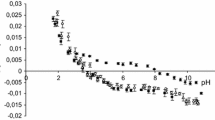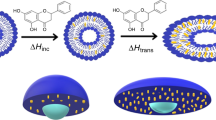Abstract
[3H]Imipramine and [3H]cocaine were concentrated at membranes of liposomes prepared from phosphatidylcholine, cholesterol, and dicetylphosphate. This “binding” has an apparent dissociation constant in the micromolar range and a density close to 2 pmol/μg of phosphatidylcholine. The potencies of various drugs in inhibiting the binding ot liposomes correlated only weakly with those in inhibiting the high-affinity binding of [3H]imipramine and [3H]cocaine to brain membranes. However, there was a highly significant correlation between the potencies of drugs in inhibiting binding to liposomes and their lipophilic character, indicating the involvement of hydrophobic bonding. Although the amounts of phosphatidylcholine and cholesterol in brain preparations in assays for high-affinity binding to brain membranes were in the same range as those used in our assays with liposomes, the inhibition of the high-affinity binding to brain membranes was only weakly dependent upon the lipophilicity of the inhibiting drug. These results indicate that lipophilicity is but one of the factors in the complex binding interactions between lipophilic substances and integral brain membranes. In addition, the results are in agreement with the suggestion that phosphatidylcholine and cholesterol are not the primary sites of high-affinity binding [3H]imipramine and [3H]cocaine to brain membranes, although it cannot be ruled out that these lipids have different properties in natural biological membranes and in artificial liposome membranes.
Similar content being viewed by others
References
Chuang, D. M., andCosta, E. 1984. Recognition sites for antidepressant drugs. Pages 307–330in: A. Lajtha, (ed.). Handbook of Neurochemistry second edition Vol. 6.
Paul, S. M., Hulihan-Giblin, B., andSkolnick, P. 1982. (+)-Amphetamine binding to rat hypothalamus: relation to anorexic potency of phenylethylamines. Science 218:487–490.
Reith, M. E. A., Sershen, H., Allen, D. L., andLajtha, A. 1983. A portion of [3H]cocaine binding in brain is associated with serotonergic neurons. Mol. Pharmacol. 23:600–606.
Sette, M., Briley, M. S., andLanger, S. Z. 1983. Complex inhibition of [3Himipramine binding by serotonin and nontricyclic serotonin uptake blockers. J. Neurochem. 40:622–628.
Lee, N. M., andSmith, A. P. 1980 Minireview. A protein-lipid model of the opiate receptor. Life Sci. 26:1459–1464.
Loh, H. H., Law, P. Y., Ostwald, T., Cho, T. M., andWay, E. L. 1978. Possible involvement of cerebroside sulfate in opiate receptor binding. Fed. Proc. 37:147–152.
Abood, L. G., andHoos, W. 1975. Stereospecific morphine adsorption to phosphatidylserine and other membranous components of brain. Eur. J. Pharmacol. 32:66–75.
Franks, N. P., andLieb, W. R. 1982. Molecular mechanisms of general anesthesia. Nature 300:487–493.
Charmichael, F. J., andIsrael, Y. 1973. In vitro inhibitory effects of narcotic analysis and other psychotropic drugs on the active uptake of norepinephrine in mouse brain tissue. J. Pharmacol Exp. Ther. 186:253–260.
Reith, M. E. A., Allen, D: L., Sershen, H., andLajtha, A. 1984. Similarities and differences between high-affinity binding sites for cocaine and imipramine in mouse cerebral cortex. J. Neurochem. 43: (in press).
Eichberg, J. Jr., Whittaker, V. P., andDawson, R. M. C. 1964. Distribution of lipids in subcellular particles of guinea pig brain. Biochem. J. 92:91–100.
Bangham, A. D. 1972. Lipid bilayers and biomembranes. Ann. Rev. Biochem. 41:753–776.
Hansch, C., andDunn, W. J. 1972. Linear relationships between lipophilic character and biological activities of drugs. J. Pharmac. Sci. 61:1–19.
Seligman, M. L., Mitamura, J., Shera, N., andDemopoulos, H. B. 1979. Corticosteroid (methylprednisolone) modulation of photoperoxidation by ultraviolet light in liposomes. Photochem. Photobiol. 29:549–558.
Reith, M. E. A., Sershen, H., Allen, D., andLajtha, A. 1983. High-and low-affinity binding of [3H]imipramine in mouse cerebral cortex. J. Neurochem. 40:389–395.
Rosenthal, H. E. 1967. A graphic method for the determination and presentation of binding parameters in a complex system. Anal. Biochem. 20:525–532.
Leo, A., Hansch, C., andElkins, D. 1971. Partition coefficients and their uses. Chem. Rev. 71:525–616.
Bermejo, J., Barbadillo, A., Tato, F., andChapman, D. 1975. Magnetic resonance studies on the interactions of antidepressants with lipid model membranes. FEBS Lett. 52:69–72.
Romer, J., andBickel, M. H. 1979. Interactions of chlorpromazine and imipramine with artificial membranes investigated by equilibrium dialysis, dual-wavelength photometry, and fluorimetry. Biochem. Pharmacol. 28:799–805.
Fernández, M. S., andCerbón, J. 1973. The importance of the hydrophobic interactions of local anesthetics in the displacement of polyvalent cations from artificial lipid membranes. Biochim. Biophys. Acta 298:8–14.
Surewicz, W. K., andLeyko, W. 1982. Interaction of local anesthetics with model phospholipid membranes. The effect of pH and phospholipid composition studied by quenching of an intramembrane fluorescent probe. J. Pharm. Pharmacol. 34:359–363.
Schlieper, P., andSteiner, R. 1983. Drug-induced surface potential changes of lipid vesicles and the role of calcium. Biochem. Pharmacol. 32:799–804.
Lapetina, E. G., Soto, E. F., andDe Robertis, E. 1968. Lipids and proteolipids in isolated subcellular membranes of rat brain cortex. J. Neurochem. 15:437–445.
Author information
Authors and Affiliations
Rights and permissions
About this article
Cite this article
Reith, M.E.A., Sershen, H. & Lajtha, A. Binding of imipramine and cocaine to a model lipid membrane. Neurochem Res 9, 965–977 (1984). https://doi.org/10.1007/BF00964527
Accepted:
Issue Date:
DOI: https://doi.org/10.1007/BF00964527




